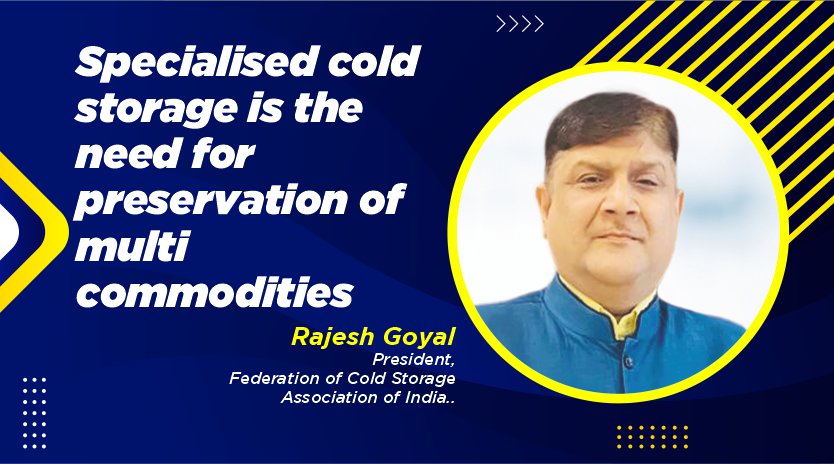Reflecting his storage perspective, Rajesh Goyal, President, Federation of Cold Storage Association of India, told Thermal Control Business Update that we need to promote natural refrigerant-based systems to protect the environment and the product being stored.
Perception of the cold storage market in India and the growth in coming years The country now needs specialised cold storage for the preservation of multi commodities. There is a huge need for this cold storage across India. Cold storage is not only a service provider for the conservation of goods but also value-added services like sorting, grading, and packing of the product.
New and innovative technologies for preserving the perishables
The basic refrigeration technology is based on Ammonia, and various institutions promote HCFC. Both have their advantages and disadvantages. However, being responsible citizens of the planet Earth, we need to promote natural refrigerant based systems that can protect the environment and the product being stored. In this respect, we are working with the Ministry of Environment, Forest and Climate Change, the Government of India and other international institutions to bring new technologies for preserving perishable goods in cold storage and transportation. These include using Liquid Ice for transport and natural refrigerants such as propane and CO2 for commercial and industrial coolers and chillers. Ammonia Glycol-based cold storage is becoming the natural choice for large plants.
Integrated automation for cold storage to handle logistical issues
In the future, automation in the cold storage industry will become a norm. As the product value stored in the cold storage goes up, the responsibility of controls is also going up. Till now, the main commodity stored in cold storage was table potato which is low-value produce and has a relatively more extensive range of storage parameters while being preserved. Now the same commodity, when stored for Industrial use (Chips, Fries or Flake etc.), needs much tighter controls, where in other parameters apart from temperatures, such as humidity, Oxygen, and CO2 levels, need very friendly control. Human intervention is no longer possible; you need proper automated systems to operate cold storage safely. Likewise, other commodities also, which are costly and delicate.
As far as the integrated automation for logistical purposes is concerned, there are cold storages in India which have installed ASRS. They are right now specific for specialised commodities or frozen cold storage. The field is new for the cold storage industry, but going forward, looking at shortage of labour and time value, it is bound to become common in the industry.
Inadequate facilities for cold storage in the country
There is a large misconception about the Cold Storage Industry. We have to segregate the Cold storage into two parts; 1, bulk cold storage has enormous capacities for storing crops like Potatoes. These types of cold storage are plentiful across the country and now have a surplus capacity as required by the country. And the second category belongs to multi-commodity cold storage having multi-chamber, multi temperature and multi-capacity facilities. This type of facility is short in supply and needs to be promoted nationwide.
Initiatives in terms of hygiene and safety
Covid has brought profound changes in terms of working in any industry. Face masks, gloves and sanitisers have become a new normal. Temperature scanners and sick room facilities are available and used across most units.
Future innovations considering changing scenarios globally
As we advance, the Indian Government is rapidly adopting and implementing the laws relating to climate change and is very serious about it. This is going to change the dynamics of the industry. We will soon be shifting out the harmful refrigerants from our equipment, residential ACs and Fridges. Commercial and Industrial ACR equipment are the most significant users of HCFC and HCFO. These refrigerants are being rapidly phased out. Europe has already limited its use and has shifted to CO2, Ammonia and Propane. They are more efficient and environmentally friendly as far as GWP and ozone depletion are concerned. We can already see the change in our home refrigerators, which now use Butane as a refrigerant.
Cookie Consent
We use cookies to personalize your experience. By continuing to visit this website you agree to our Terms & Conditions, Privacy Policy and Cookie Policy.













